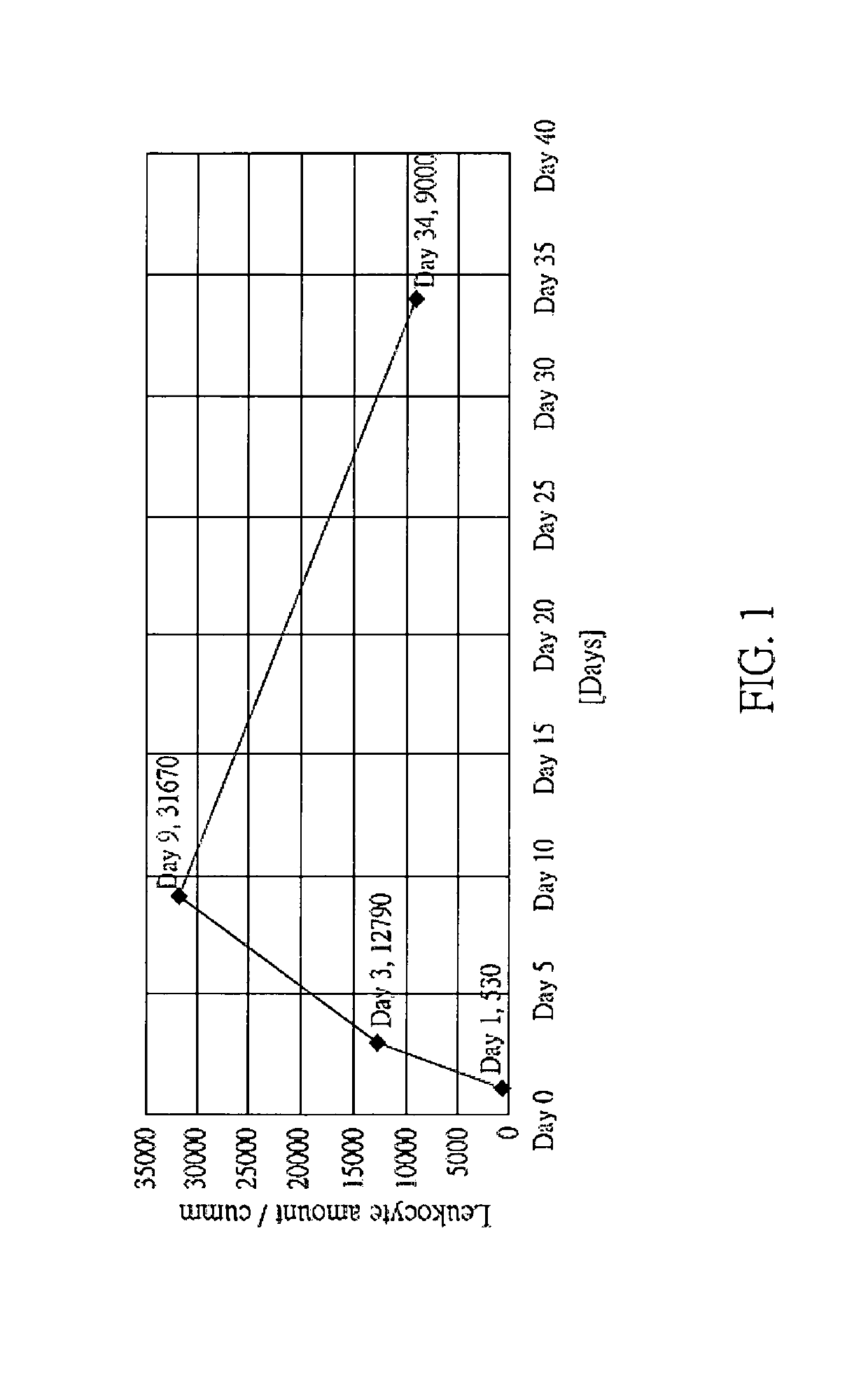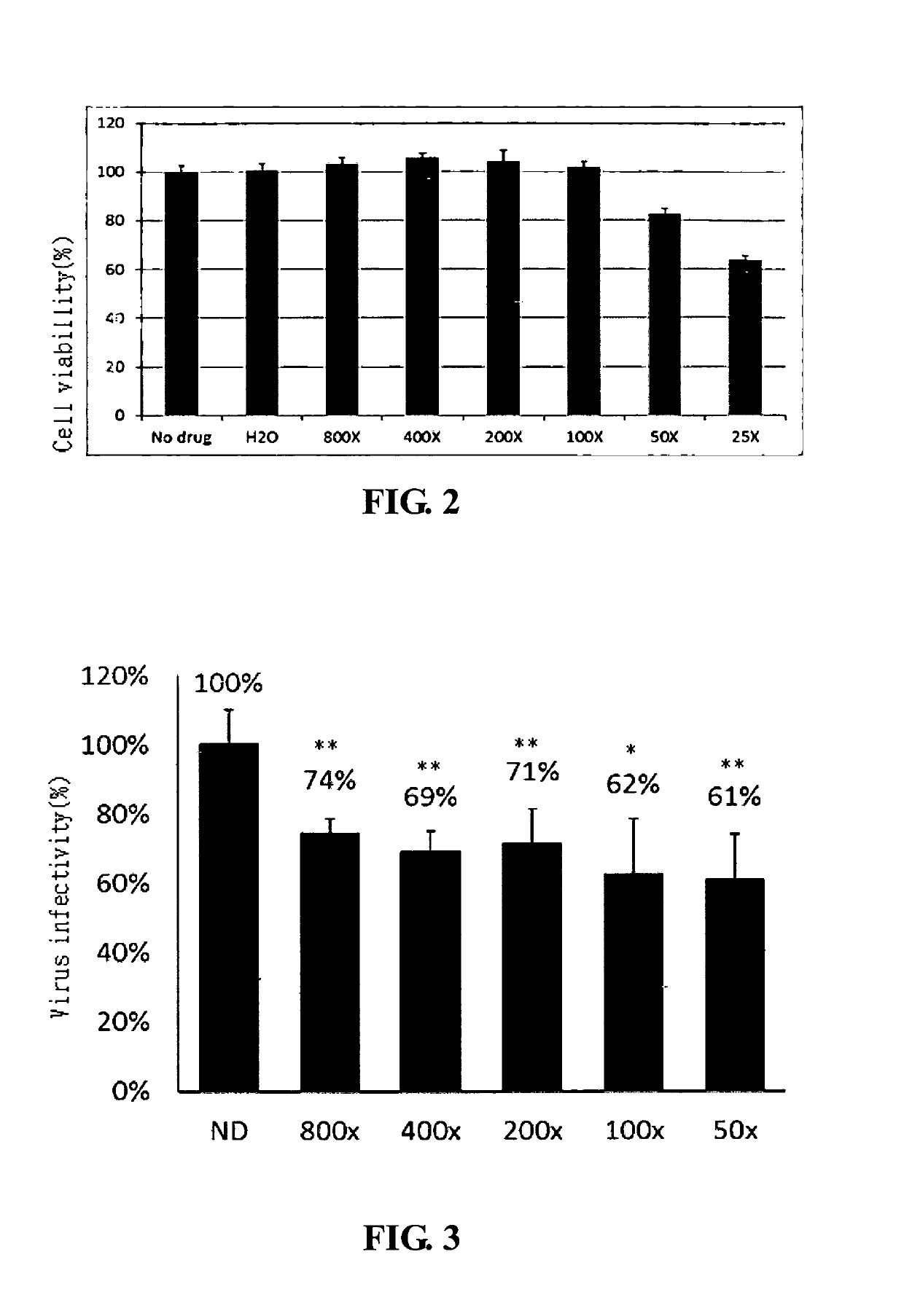Method for treating a glycoprotein-related disease
a glycoprotein and drug technology, applied in the field of glycoprotein related drug treatment, can solve the problems of abnormal glycosylation between carbohydrates and proteins in eye lens cells, no effective drug treatment and prevention of prion infection, blurred vision, etc., and achieve good treating effect on various diseases and better treatment effect of combination
- Summary
- Abstract
- Description
- Claims
- Application Information
AI Technical Summary
Benefits of technology
Problems solved by technology
Method used
Image
Examples
embodiment 1
[0254]In the present embodiment, feline immunodeficiency virus (FIV), which is belonged to the same family (Retroviridae) and the same genus (Lentivirus) to HIV, was selected to perform the present clinical experiment. LuMC5 was administered to the infected cat via intravenous injection or intramuscular injection, 0.4 cc / kg, once or twice a day. The results are shown in the following Table 1 and FIG. 1.
[0255]
TABLE 1Blood cells examination data of FIV infected cat during thetreatment (Testing company: LEZEN Reference Lab)WBCNEULYMMONOEOSIBASODay 153018.943.437.700Day 31279073106.60.30.1Day 93167080964.90.1Day 3490006924520.1RBCHgbHCTM.C.VM.C.HM.C.H.CPLTDay 17.8412.144.556.815.427.256Day 37.711.942.154.715.528.3165Day 96.8210.634.85115.530.5132Day 346.7110.237.555.915.227.238NEU: Neutrophils / LYM: Lymphocytes / MONO: Monocytes / EOSI: Eosinophils / BASO: Basophils / Hg: Hemoglobin / HCT: Hematocrit /
[0256]From the results shown in FIG. 1 and Table 1, the immune cell amount was increased rapidly a...
embodiment 2
[0259]In the present embodiment, MASA and LuMC5 were used to treat the virus infected vertebrate and mammalian. 7 virus species belonged to 5 families were selected to perform the present clinical experiment. Herein, the virus classification is on the basis of National Center for Biotechnology Information, U. S.
Subject: Infected dogs and cates sent to Hei-Ming Veterinary Hospital, Taiwan
7 virus species for clinical experiments:
Family: Retroviridae
[0260]Genus: Gammaretrovirus [0261]species: Feline leukemia virus [0262]Genus: Lentivirus [0263]species: Feline immunodeficiency virus
Family: Parvoviridae[0264]species: Canine parvovirus [0265]species: Feline panleukopenia virus
Family: Paramyxoviridae[0266]Genus: Morbillivirus [0267]species: Canine distemper virus
Family: Coronaviridae[0268]Genus: Alphacoronavirus [0269]species:Feline coronavirus
Family: Herpesviridae[0270]Genus: Varicellovirus [0271]species: Felid herpesvirus 1
Treatment: Intravenous injection or intramuscular injection, ...
embodiment 3
[0286]In the present embodiment, LuMC5 was used to treat the mammalian with hemorrhagic venom infection and neurotoxic venom.
Subject: Infected dogs and cates sent to Hei-Ming Veterinary Hospital, Taiwan
Treatment: Intravenous injection or intramuscular injection, 0.4 cc / kg, once or twice a day
[0287]The testing results s in the clinical experiments of the present embodiment are listed in the following Tables 3-1 to 3-3.
[0288]
TABLE 3-1Results of the clinical experiments on the subject infected withhemorrhagic venom infection of Trimeresurus mucrosquamatusAnimalTime toAdministeredSyndromes before treatment& IDAgeGenderbe treatedtimesCondition after treatmentDog3M2 hours1Depression, lifeless, sticky saliva,130420yearsafterand facial and head swellinginfectionDepression and lifeless were relieved,1 hours after treatment.Facial and head swelling were relieved,12 hours after treatment.Dog6F2 hours2Facial swelling, depression, lifeless,140405yearsafterand mouth and tongue blood stasisinfecti...
PUM
| Property | Measurement | Unit |
|---|---|---|
| swelling | aaaaa | aaaaa |
| acid-base | aaaaa | aaaaa |
| morphology | aaaaa | aaaaa |
Abstract
Description
Claims
Application Information
 Login to View More
Login to View More - R&D
- Intellectual Property
- Life Sciences
- Materials
- Tech Scout
- Unparalleled Data Quality
- Higher Quality Content
- 60% Fewer Hallucinations
Browse by: Latest US Patents, China's latest patents, Technical Efficacy Thesaurus, Application Domain, Technology Topic, Popular Technical Reports.
© 2025 PatSnap. All rights reserved.Legal|Privacy policy|Modern Slavery Act Transparency Statement|Sitemap|About US| Contact US: help@patsnap.com


